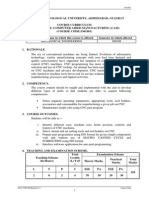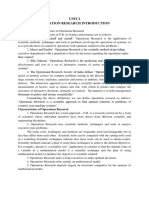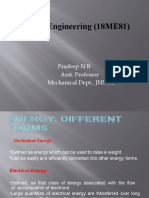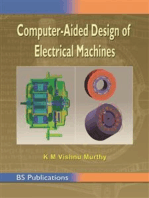Design and Fabrication of Light Electric Vehicle
Design and Fabrication of Light Electric Vehicle
Uploaded by
Ashish NegiCopyright:
Available Formats
Design and Fabrication of Light Electric Vehicle
Design and Fabrication of Light Electric Vehicle
Uploaded by
Ashish NegiOriginal Description:
Copyright
Available Formats
Share this document
Did you find this document useful?
Is this content inappropriate?
Copyright:
Available Formats
Design and Fabrication of Light Electric Vehicle
Design and Fabrication of Light Electric Vehicle
Uploaded by
Ashish NegiCopyright:
Available Formats
Design and Fabrication of Light Electric
Vehicle
Group Member
Digvijay Chauhan(47)
Pulkit Kukreja(40)
Ashwani Kumar Gupta(43)
CONTENTS
Objective
Introduction
Methodology
Advantage & Disadvantage
Initial design
Chassis design
Objective
To design and fabricate a single seater compact electric
towing truck which can be used for localised movements of
goods.
INTRODUCTION
The designed and fabricated an electric two
vehicle for in house movements of goods. The
vehicle has industrial importance. It is directed
towards medium and small scale industries, e.g.
duplex and craft industry, hospitals and airports
to carry loads/goods up to the range of hundred
kilograms on a gradient of twenty percent.
Methodology
PHASE 1:
Main focus on :
Motor
Controller
Batteries
Further a thorough study on available and types of motor in
terms of applicability, advantages and disadvantages keeping in
mind the vehicle.
Simultaneously, a study on the compatible control system would
be carried out which involves speed control, battery meter,
speedometer , LED display etc .
Methodology
PHASE 2:
This phase would start with the final review of design.
The fabrication of the vehicle would then commence based
on the final design.
The vehicle would be taken for testing in campus with or
without load, so as to verify its applicability.
ADVANTAGE
Fast and simple charging even after prolonged
storage.
High number of charge/discharge cycles;
provides over 1,000 charge/discharge cycles with
proper maintenance.
Good load performance; rugged and forgiving if
abused.
Long shelf life; can be stored in a discharged
state.
DISADVANTAGE
Requires protection circuit to limit voltage and
current
Limited service life.
INITIAL DESIGN
Chassis Design
A frame is the main structure of the chassis of a motor
vehicle. All other components fasten to it; a term for this
design is body-on-frame construction. The basic function
of the frame is:
i. To support the chassis components and the body.
ii. To withstand static and dynamic loads without undue
deflection or distortion.
CONCLUSION
The converted vehicle is in its optimization stages.
Our design of experiment consists of acceleration
and top speed tests with varying number of batteries.
. The range test will also be conducted varying the
number of batteries and different noises such as air
conditioning and lights
Reference
James Larminie - Electric vehicle technology explained.
www.greenstudentu.com/encyclopedia/green-vehicle-
guide/electric_car
Alternate fuels for transportation, Arumugam S.
Ramadhas, CRC Press, Taylor and Francist group
You might also like
- India Strategy - Modi 3.0 21may24 - BernsteinDocument21 pagesIndia Strategy - Modi 3.0 21may24 - BernsteinAbhinav BhattNo ratings yet
- ND Mech Eng TechDocument183 pagesND Mech Eng TechShamsudeen Abubakar SodangiNo ratings yet
- Abu Dhabi University GEN 200 Engineering Economy Fall 2016 Term Project Due: Wed November 23, 2016Document6 pagesAbu Dhabi University GEN 200 Engineering Economy Fall 2016 Term Project Due: Wed November 23, 2016Yong JinNo ratings yet
- Marking Forms With Aspects Mechanical Engineering Design-CADDocument10 pagesMarking Forms With Aspects Mechanical Engineering Design-CADNguyen Quoc TuanNo ratings yet
- Lecture 4 Sem5A 23 Part1Document43 pagesLecture 4 Sem5A 23 Part1Joshua Geddam 2No ratings yet
- Unit 3Document95 pagesUnit 3zubbbuNo ratings yet
- Chapter 3 - Orthographic Projections in AutoCAD 2016Document38 pagesChapter 3 - Orthographic Projections in AutoCAD 2016bmyertekinNo ratings yet
- FDP Brochure HeatDocument2 pagesFDP Brochure HeatKesavan DhuraiNo ratings yet
- Lapping Process - Definition, Working Principle, Types, Material, Advantages, Application (Notes With PDF) - Learn MechanicalDocument13 pagesLapping Process - Definition, Working Principle, Types, Material, Advantages, Application (Notes With PDF) - Learn MechanicalMirko DujmićNo ratings yet
- CH 21Document45 pagesCH 21Anonymous p0mg44xNo ratings yet
- Meeting Minutes With HODsDocument4 pagesMeeting Minutes With HODsRushi Padmanabhuni100% (1)
- GE 6261 Final PDFDocument58 pagesGE 6261 Final PDFPrasath Murugesan0% (1)
- Lab Manual 2 PrintDocument17 pagesLab Manual 2 Printmonikandakumar ramachandranNo ratings yet
- Design of Form ToolsDocument2 pagesDesign of Form ToolsSunny GaekwadNo ratings yet
- Experiment 4 Introduction To Proteus, LED: Embedded Systems LaboratoryDocument7 pagesExperiment 4 Introduction To Proteus, LED: Embedded Systems LaboratoryJocelyn GempisaoNo ratings yet
- General Purpose Machine Tools - SpalDocument33 pagesGeneral Purpose Machine Tools - SpalmecoolguysNo ratings yet
- Metrology Lab Viva Voce QuestionsDocument6 pagesMetrology Lab Viva Voce Questionsmrbalaji88No ratings yet
- Robotics Chapter 6 - Robot ProgrammingDocument9 pagesRobotics Chapter 6 - Robot Programmingtutorfelix777No ratings yet
- Project: Design and Analysis of Shock AbsorberDocument18 pagesProject: Design and Analysis of Shock AbsorberKunal KureelNo ratings yet
- Computer Aided Engg DrawingDocument2 pagesComputer Aided Engg DrawingVikram RaoNo ratings yet
- Final Report of Robotic WeldingDocument8 pagesFinal Report of Robotic Weldingveereshkoutal100% (1)
- R&ac Course FileDocument26 pagesR&ac Course Fileddownload 1100% (1)
- Chapter 1 Introduction To Mechanical WorkshopDocument10 pagesChapter 1 Introduction To Mechanical WorkshopDipayan DasNo ratings yet
- Cam Lab ManualDocument14 pagesCam Lab Manualelangandhi0% (1)
- CAMDocument9 pagesCAMJay JoshiNo ratings yet
- Programmable Logic Controllers Tutorial - Outcome 1: D.J.Dunn 1Document0 pagesProgrammable Logic Controllers Tutorial - Outcome 1: D.J.Dunn 1Anurag GuptaNo ratings yet
- FM Lab ManualDocument68 pagesFM Lab Manualommech2020No ratings yet
- .NG Mec 224 Properties of Mat TheoryDocument73 pages.NG Mec 224 Properties of Mat TheoryYusuf taiwoNo ratings yet
- Solar Energy Measurement SystemDocument8 pagesSolar Energy Measurement SystemLuke Nihal DasariNo ratings yet
- ME2257-Machine Drawing ManualDocument62 pagesME2257-Machine Drawing ManualVPSureshKumar100% (4)
- DFM LabDocument13 pagesDFM LabnannupnNo ratings yet
- Unit-4 MMDocument74 pagesUnit-4 MMRama SamyNo ratings yet
- Manufacturing Process Point Vise Syllabus From RaghuvanshiDocument3 pagesManufacturing Process Point Vise Syllabus From RaghuvanshiRAMAKANT RANANo ratings yet
- Question Bank - Unit Test 1 Advanced Manufacturing Processes (22563)Document2 pagesQuestion Bank - Unit Test 1 Advanced Manufacturing Processes (22563)6403 Rohit Gaikwad0% (1)
- Assignment ON Operation ResearchDocument15 pagesAssignment ON Operation ResearchHimansu Sekhar BarikNo ratings yet
- CHAPTER 6 System Techniques in Water Resuorce PPT YadesaDocument32 pagesCHAPTER 6 System Techniques in Water Resuorce PPT YadesaGod is good tubeNo ratings yet
- Engineering Seminar Topics:: Seminar Paper: 3D Printing TechnologyDocument6 pagesEngineering Seminar Topics:: Seminar Paper: 3D Printing TechnologyAyush SinghalNo ratings yet
- Automation of Electrical Machine NotesDocument40 pagesAutomation of Electrical Machine Notesurbanus mutungaNo ratings yet
- Mechanical Measurement and MetrologyDocument2 pagesMechanical Measurement and MetrologyNarayanarao PalagaraNo ratings yet
- Cam Lab 1Document40 pagesCam Lab 1Madhusudhan Rao KNo ratings yet
- Mechanical ScienceDocument8 pagesMechanical ScienceAbhishek Mitra100% (2)
- Degree: B.E. Regulation: 2008 Branch: Mechanical Engineering Semester: 05 Duration: 3 Hours Max. Marks: 100Document48 pagesDegree: B.E. Regulation: 2008 Branch: Mechanical Engineering Semester: 05 Duration: 3 Hours Max. Marks: 100kaliappan45490No ratings yet
- Me2026 Ucmp Unit 1Document32 pagesMe2026 Ucmp Unit 1velavansuNo ratings yet
- Borja, Benedict C. October 19, 2020 Engr Julio B. CasDocument10 pagesBorja, Benedict C. October 19, 2020 Engr Julio B. CasJayven BorjaNo ratings yet
- Automation Principles and StrategiesDocument25 pagesAutomation Principles and StrategiessrikanthNo ratings yet
- MF 5103 Advanced in Casting Welding 13 MarkDocument1 pageMF 5103 Advanced in Casting Welding 13 MarksparktoreachNo ratings yet
- Flaciah Wanjiku Munyua Final ProjectDocument102 pagesFlaciah Wanjiku Munyua Final Projectaldrin castigoNo ratings yet
- Unit 2 Traditional Machine TheoryDocument80 pagesUnit 2 Traditional Machine Theorymandefro2No ratings yet
- Unit I Operation Research Introduction: Characteristics of Operations ResearchDocument90 pagesUnit I Operation Research Introduction: Characteristics of Operations ResearchhariroopganeshNo ratings yet
- Energy Engineering (18ME81) : Pradeep N B Asst. Professor Mechanical Dept., JNNCEDocument50 pagesEnergy Engineering (18ME81) : Pradeep N B Asst. Professor Mechanical Dept., JNNCEPradeep N BNo ratings yet
- Mechanical Design DocumentDocument13 pagesMechanical Design DocumentJaishikha DawahooNo ratings yet
- CH 7 Numerical ControlDocument40 pagesCH 7 Numerical ControlJapneet GhaiNo ratings yet
- FT Lab Manual27-12-17 PDFDocument48 pagesFT Lab Manual27-12-17 PDFJay JoshiNo ratings yet
- ME83691-Computer Aided Design and ManufacturingDocument15 pagesME83691-Computer Aided Design and Manufacturingraman thiru55No ratings yet
- CADCAMDocument50 pagesCADCAMPrem Chander100% (5)
- Analysis of The Performance and Overall Efficiency of A Formula Student Electric CarDocument12 pagesAnalysis of The Performance and Overall Efficiency of A Formula Student Electric Carleone.martellucciNo ratings yet
- Final Project Report 1Document99 pagesFinal Project Report 1Sikander GirgoukarNo ratings yet
- Manual de Usuario DTMDocument44 pagesManual de Usuario DTMAntonio Chuman MedinaNo ratings yet
- Prepositions, A GuideDocument32 pagesPrepositions, A GuideGigliane SouzaNo ratings yet
- CR10121 CR10221: S.No - Regi OnDocument243 pagesCR10121 CR10221: S.No - Regi OnHarsha VenkataNo ratings yet
- Online Quiz 1Document2 pagesOnline Quiz 1Ruben Pulumbarit IIINo ratings yet
- Assessment of Tunnelling-Induced Building DamageDocument10 pagesAssessment of Tunnelling-Induced Building DamageMarco NevesNo ratings yet
- Week 9-11 (Nutrition)Document6 pagesWeek 9-11 (Nutrition)Yoko Mae YanoNo ratings yet
- Physics ReviewerDocument4 pagesPhysics ReviewermeriiNo ratings yet
- Juno 3 SeriesDocument2 pagesJuno 3 SeriesImam BuchairiNo ratings yet
- Switch Below For Different ECU's: LegendDocument11 pagesSwitch Below For Different ECU's: LegendReza VaraminiNo ratings yet
- Trench AssaultDocument4 pagesTrench AssaultJim Wallman100% (1)
- Q1. Comprehension: (5marks) Read The Passage Carefully Then Answer The Questions Given at The EndDocument5 pagesQ1. Comprehension: (5marks) Read The Passage Carefully Then Answer The Questions Given at The EndSana AliNo ratings yet
- Module 1: Creation Spirituality: Why Do We Need To Care God's Creation?Document8 pagesModule 1: Creation Spirituality: Why Do We Need To Care God's Creation?Philip Wenceslao DelgueraNo ratings yet
- Introduction To Philosophy of The Human NatureDocument44 pagesIntroduction To Philosophy of The Human NatureButterfly Fashion100% (1)
- 1 Final IntroductionDocument7 pages1 Final Introductionravi singhNo ratings yet
- PELATIHANDocument9 pagesPELATIHANRizka Amelia IstyNo ratings yet
- Precision ToolsDocument32 pagesPrecision Toolshmirfan81No ratings yet
- RP8100Document4 pagesRP8100Ana Cecilia Gallegos PachecoNo ratings yet
- Massey Ferguson MF 440 Combine Parts Catalogue ManualDocument25 pagesMassey Ferguson MF 440 Combine Parts Catalogue ManualAmri Mangun0% (1)
- Slide-Chapter 1 STDocument54 pagesSlide-Chapter 1 STpttd154No ratings yet
- Electronic TimersDocument54 pagesElectronic Timersbhupi dagarNo ratings yet
- Wien Bridge Oscillator DesignDocument16 pagesWien Bridge Oscillator DesignReece RevosaNo ratings yet
- Endodontic Orthodontic Relationships A Review of Integrated Treatment PlanningDocument18 pagesEndodontic Orthodontic Relationships A Review of Integrated Treatment PlanningAlfonso SernaNo ratings yet
- 5 StarDocument19 pages5 Starpagidimarrysaiakhil137No ratings yet
- Periodontology 2000 - 2021 - Hajishengallis - Polymicrobial Communities in Periodontal Disease Their Quasi OrganismalDocument21 pagesPeriodontology 2000 - 2021 - Hajishengallis - Polymicrobial Communities in Periodontal Disease Their Quasi Organismalalan.da.s.aguirreNo ratings yet
- Nutritional FactsDocument1 pageNutritional FactsAngelie Fey OngNo ratings yet
- Chemistry Investigatory Project Class 12 - ToothpasteDocument20 pagesChemistry Investigatory Project Class 12 - ToothpasteKishoreNo ratings yet
- General SpecificationDocument327 pagesGeneral SpecificationmaymanyassinNo ratings yet
- DIY Powerful Induction Heater: InstructablesDocument16 pagesDIY Powerful Induction Heater: Instructablesdaritemanmu100% (1)
- Kawabata Yasunari - A Critical IntroductionDocument20 pagesKawabata Yasunari - A Critical IntroductionMatChiappeNo ratings yet

























































































